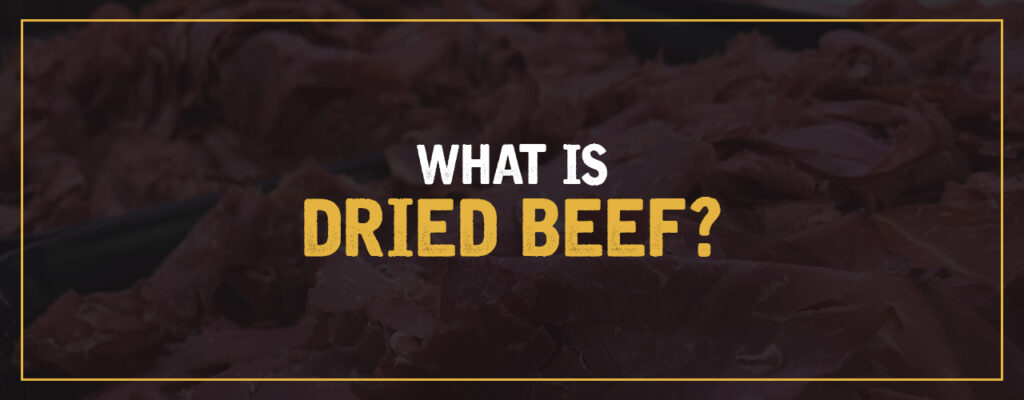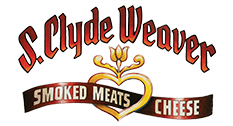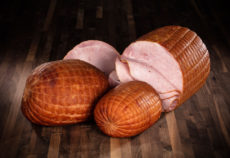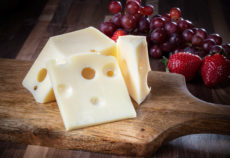
Dried beef, also called chipped beef, is beef that has been partially dried, salt-cured and thinly sliced. You can easily enjoy this cured meat as an appetizer, snack or meal. Dried beef has a rich past but is a relatively obscure meat product in most parts of the country today. If you’ve never tried dried beef, you’re in for a treat!
From rich creamed chipped beef to salty, protein-packed snacks, smoked dried beef is a flavorful and versatile cured meat to enjoy for breakfast, lunch, dinner or any time in between. It’s the ultimate comfort food, worth enjoying for the first time or preparing in a way you’ve never had before.
What Is Dried Beef Made From?
Any type of lean beef can be cured to make dried beef. Makers will trim any fat off the cut of meat since fat compromises preservation. Some varieties of dried beef are made from chopped-up beef that is pressed together to form a log before being sliced, while others come from whole cuts. S. Clyde Weaver’s famous dried beef comes from top-quality beef knuckles, a lean cut of meat from the round primal cut.
Unlike sausages and some other types of cured meats, dried beef generally doesn’t contain spices. It only includes curing agents, giving it a salty flavor. Smoking adds another depth of flavor to dried beef. The concentrated smoky, salty, meaty flavor of chipped beef makes it a great add-in for countless dishes. You may also enjoy eating it straight from the package.
How Is Dried Beef Made?
Dried beef goes through a drying process, though it won’t end up as dehydrated as jerky, another type of cured beef product. Drying isn’t the only source of preservation, either — chipped beef is also salt-cured. The exact process of salting and drying differs between makers and has evolved over time. Dried beef may also be pressed before being sliced. The result is thin, flexible slices of meat with a strong, concentrated taste. It comes presliced and packaged in jars, cans or plastic pouches.
S. Clyde Weaver’s early salt curing methods involved salting the beef knuckles in large batches, allowing them to cure in coolers for weeks. They were then soaked to lower the salt content and smoked to up the flavor. Today, other makers are more likely to use liquid cure that can penetrate the beef and instantly cure it.
Not all dried beef is smoked, but smoking the product is a popular way to infuse extra flavor. Many makers may impart a smoke flavor artificially, though some artisanal companies like S. Clyde Weaver still use a traditional smoking process as the meat dries.
The History of Dried Beef
People have been preserving meat since ancient times, and the earliest and most popular method they used for preservation was drying. Salting has also been a popular means of preservation over the centuries. Removing moisture from meat prevents bacteria, fungi or autolytic enzymes from being able to react with food. In the past, without methods like freezing and refrigeration, curing meat was essential to make it last so none went to waste. People then had access to meat products, even when freshly butchered options weren’t readily available.
Even though we have easier access to refrigerators and freezers today, preserved meats remain popular. Dried beef is obscure compared to some other dried and cured products — especially to people outside of Pennsylvania, where the product is said to have originated. You can still find meals made with chipped beef in some Pennsylvania diners and homes.
It isn’t clear when Pennsylvanians started making dried beef, but we do know it became popular in the 20th century in the U.S. military. Many people today still associate the meat with the Army, especially, though it was also served in the Navy. Military cooks used dried beef in recipes because it was economical, flavorful and protein-packed. World War I and World War II military-issued cookbooks, starting with the 1910 edition, featured recipes for creamed chipped beef on toast.
There were also similar recipes for creamed sliced dried beef. Chipped beef on toast was especially popular, so much so that it took on many nicknames. Many soldiers referred to it as S.O.S., which stood for several phrases, including “save our stomachs,” “same old stuff,” “stew on a shingle” and a more crude term of endearment. Many soldiers considered S.O.S. a part of the military experience.
S.O.S. was often served for breakfast. The hot meal was salty, flavorful and fortifying to soldiers away from home. It remains a popular dish for many people today, including veterans and others who enjoy the homey feel they get from a bite of delicious creamed chipped beef. Of course, there are many other dried beef recipes you can try, but there’s no doubt that this creamy dish is the most popular way of serving chipped beef.
What Can Dried Beef Be Used For?
There are several ways you can enjoy dried beef. Once you have some smoked dried beef on hand, you’ll be looking for new ways to enjoy this product. Here are a few ideas for using chipped beef for breakfast, lunch, dinner and snacks.
1. Creamed Chipped Beef
We touched on the history of creamed chipped beef, also known as S.O.S. In the Pennsylvania Dutch community, you may hear this famous dish referred to as “Dutch frizzled beef.” Whatever you call it, it’s delicious and is by far the most popular dish for dried beef. Fortunately, you can easily make creamed dried beef at home with simple ingredients.
You’ll find many versions of this recipe, but it essentially consists of pieces of dried beef in a béchamel sauce. Don’t let the name intimidate you. Béchamel is a simple white sauce many cooks use to make white gravy, beginning with a roux of fat and flour. Then you add milk, which thickens from the roux. Some recipes start with the chipped beef in the pan, while others may suggest adding it at the end.
There are plenty of variations on the classic recipe. A common addition is diced, sautéed onion, but you can also add other vegetables like peas or corn. You could even melt some shredded cheese into the sauce. Some recipes suggest topping with fresh parsley or using certain spices to influence the flavor of the dish. Try the classic version and see what add-ins you or your family enjoy.
The 1910 Army recipe for stewed chipped beef included beef stock along with the béchamel ingredients. But most recipes after that left out the stock to achieve a creamier, thicker gravy. This dish is most often served over toast, though you can also enjoy it over potatoes, noodles, biscuits or other starchy foods. If you enjoy biscuits and sausage gravy, you’ll notice similarities between these dishes, though chipped beef tends to be saltier.
Most people are more likely to have tried biscuits and gravy rather than creamed chipped beef on toast. If you’re in Pennsylvania, you may see this dish on breakfast menus in local restaurants. The regional favorite is a rare find, though, in restaurants outside of Pennsylvania.
2. Scrambled Eggs and Chipped Beef
For breakfast, try chipped beef with scrambled eggs. If you ever tried adding bacon or sausage crumbles or chunks of ham to scrambled eggs, then you know just how delicious the meal can become with the addition of salty, cured meat. Dried beef is a great alternative to try. Add in your favorite veggies or cheeses to create your perfect breakfast scramble.
You can also combine this idea with creamed chipped beef, ladling the white gravy and meat over scrambled or fried eggs. Add a piece of toast, an English muffin or a biscuit to soak up some of that delicious, rich gravy. Nothing will feel quite as hearty or straight from a farmhouse breakfast table than this meal.
3. Deli Sandwich
The simplest way to enjoy dried beef is to eat the slices straight from the packaging. Since the meat is cured, you don’t need to cook or otherwise prepare it before consuming it. Try a slice of smoked dried beef on a cracker or in between slices of bread as a sandwich. You can add all your favorite toppings and condiments as you would with other sandwiches.
Just keep in mind that dried beef can pack a stronger flavor than you may be used to from other varieties of deli meat. You won’t need to load up a sandwich with stacks of slices — instead, make a flavorful meal with just a bit of dried beef. You might also find you enjoy it best as an addition to other milder deli meats. Make a turkey sandwich, for instance, and add a slice of dried beef for extra flavor.
4. Cheese Ball
Cheese balls are a popular appetizer that can be casual enough for a game day get-together or elegant enough for an upscale dinner party. Many cheese ball recipes include diced ham or bacon bits, but some recipes call for dried beef. Cheese ball recipes typically start with cream cheese and can contain various other ingredients mixed in. Some staple additions in dried beef cheese balls are chopped green onions and Worcestershire sauce. You can also add shredded cheese.
Dried beef is an excellent choice for a cheese ball because it will cut the mild cream cheese with a delicious, salty flavor. You can also roll your cheese ball in chopped dried beef, or just include the beef inside and roll the ball in chives, nuts or another ingredient that can double as both garnish and added flavor. Serve the cheese ball with your favorite crackers.
5. Hot Virginia Dip
Another scrumptious appetizer using dried beef is known as hot Virginia dip. The base of the dip is a combination of cream cheese and sour cream. Add a little bit of milk and butter to increase the dip’s creamy richness and complement chipped beef’s saltiness. Minced dried beef is the staple ingredient, which flavors the dip, along with garlic and minced white or green onion. There are many versions of dried beef dip you can make. Add in all sorts of ingredients and serve it hot or cold.
For hot Virginia dip, though, you must top with toasted pecans, bake the dip and serve it hot and melty. It’s delicious with toasted baguette or pumpernickel slices or crackers. You can make this dip ahead and wait until shortly before serving time to stick it in the oven. Everyone enjoys a good dip, and hot Virginia dip is a delicious option your guests may have never tried before.
6. Charcuterie Board
Another way to serve dried beef is alongside other cured meats and cheeses on a charcuterie board. Of course, to earn a spot on your board, the dried beef should be high-quality. Prepackaged grocery store varieties may not be the best choice when you’re trying to create a sophisticated assortment of meats, cheeses and other delicacies.
A great charcuterie board should provide plenty of variety, which you can achieve through the various cheeses, crackers, fruits, nuts, olives, spreads and jellies you include. But what about the meat on the board? Many cured meats that are traditional inclusions on a charcuterie board — including prosciutto, salami and pepperoni — are made from pork. That’s why adding smoked dried beef is an excellent idea to diversify the meat selections. Since smoked dried beef is a cured product with a flavorful punch, it’s perfect for a charcuterie board.
7. Dill Pickle Wraps
Dill pickle wraps are easy to put together and are a fun snack or appetizer to serve at a barbecue, tailgate or party. These wraps include dill pickle spears, cream cheese and dried beef. The tanginess of the cream cheese, tartness of the dill pickles and saltiness of the dried beef create a dream combination of flavors. You can also chop up your pickles and dried beef and mix them in cream cheese to make a dip version of this appetizer.
Start by encasing dill pickle spears in cream cheese. Then wrap slices of dried beef around the cream cheese pickles. You can use multiple slices of meat and stick them together with another smear of cream cheese. After assembling, refrigerate the pickle wraps to let them firm up. Once they’re chilled, use a serrated or electric knife to slice the spears, creating colorful medallions that pack a real flavor punch.
Tips for Cooking Dried Beef
Whatever you’re creating in the kitchen using dried beef, there are a few tips to keep in mind. Of course, your own preference is the most important thing to pay attention to, but you may enjoy your dried beef more by sticking to these practices.
1. Choose a Quality Product
Our first tip is to purchase dried beef that is made from quality cuts of meat and created using authentic ingredients and processes. S. Clyde Weaver’s dried beef is some of the best you’ll find on the market. It’s made from quality beef knuckles that are slow-dried and smoked over two weeks.
The result is a savory, high-quality product that blows away low-quality, prepackaged versions of dried beef at the grocery store. Delicious, authentic products may cost more, but a little dried beef goes a long way in dishes, so it’s worth spending a bit more for the real thing.
2. Taste Before Salting
Because dried beef is generously salted, you may find that adding it to dishes eliminates or diminishes the need to add any other salt. We recommend holding off on adding salt to a dish until after you’ve added the dried beef. You can then taste the dish and decide how much salt to add or whether you need any at all.
Adding the dried beef in early during the cooking process will allow the salt to permeate the rest of the dish. Put the ingredient in at the end, and you’ll have a dish that tastes less salty. Whether you add salt or not, you may want to sprinkle in other seasonings that traditionally pair well with dried beef, such as garlic, onion or pepper. Some dried beef dishes call for Worcestershire sauce, which will increase the saltiness of the dish, as well.
3. Rinse to Reduce Saltiness
Maybe you want to enjoy dried beef, but you don’t prefer a salty flavor or you want to cut down on the sodium. To reduce the level of saltiness in a dish containing dried beef, rinse or soak the ingredient first. After rinsing, be sure to dry the beef off before you add it to recipes so it won’t be soggy and make for a watery dip or gravy.
If you’re concerned about salt content, you can also reduce the amount of dried beef in a dish. Because the savory, salty flavor is so concentrated, a small amount can effectively flavor a large portion. Of course, how much you add will also depend on whether the beef is there for a bit of flavor or is a main source of protein. The original Army recipe for chipped beef called for 15 pounds of beef to feed 60 soldiers, equating to a hearty 4-ounce serving of meat per person.
4. Use Alongside Mild Flavors
Because of that concentrated flavor, you’ll notice dried beef recipes typically pair the cured meat with mild ingredients — often dairy ingredients like milk, sour cream or cream cheese. You could also try adding dried beef to more flavorful dishes. For instance, you can create a spicy dip using the ingredient.
However, most people prefer the balance they achieve with milder flavors that allow the dried beef to be the star of the show. Creamed chipped beef is a perfect example of this since the ingredients are so simple and do not overshadow the taste of the beef.
5. Elevate With Something Fresh
Another way to balance out rich, salty dried beef dishes is with something fresh. For instance, you can create a delicious cheese ball with just cream cheese, dried beef and some seasonings. But you can elevate that taste by adding some chives or green onions.
Creamed chipped beef is sometimes served with fresh parsley on top, which achieves the same effect. Play around with other herbs that complement savory dishes to find your ideal fresh flavor combination. There’s certainly something to be said for a dish with a pure homey richness. But if you want to freshen up a dried beef recipe, add some green.
Enjoy the Unmatched Quality and Flavor of S. Clyde Weaver’s Smoked Dried Beef
If you want to try dried beef for the first time or enjoy the nostalgic taste of this classic, enjoy the thinly sliced smoked dried beef from S. Clyde Weaver. Like our other products, our dried beef is made with the same commitment to quality ingredients and time-honored processes. We’re a Lancaster County company that has been making dried beef for a century. You can rest assured our smoked dried beef is as authentic and as delicious as it gets.
Browse our online store to see what other savory, smoked delicacies you can try at your next snack time, family dinner or social gathering!














I’m an almost 77-year-old, transplanted Pennsylvanian lady whose father was the owner of West End Meat Market in Quakertown, PA. I was truly spoiled with some of the most tasty meats … most all of my favorites lacking here int the “Inland Empire” of Washington State. I really miss those meats, their aromas and especially their tastes. Recently, I asked my younger brother if he remembered how our dad made dried beef, however, he, too, doesn’t remember anything except the beef knuckle was first brined and then put in dad’s smokehouse. We’re both too soon old, too late smart, oh, well. I was able to find a meat market in Spokane (Sonnenberg’s) who ordered two, about 30lb. chubs of Lebanon bologna for me from somewhere back east. Spokane is 80 miles from my rural home so a friend picked it up for me and another friend brought it to me. Thought I died and was in heaven with my first bite. I shared it with a few other transplanted Pennsylvanians so it was gone pretty fast. I started remembering how tasty Dad’s chipped beef was and decided to look up the history of chipped beef. THANK YOU for you wonderful information. Are you aware of ANY place in Eastern Washington (state) that sells chipped beef? If so please let me know.
Remember to slive across grain to keep the tender meat
I love dried beef. My great-great Grandmother was from Germany, and passed her German-style foods down.
The question I have is , the dried beef preserved with nitrates or just salt?
How long can you keep it refrigerated?
Can i get a sample of the fired beef?
Can I order a piece of the dried beef?